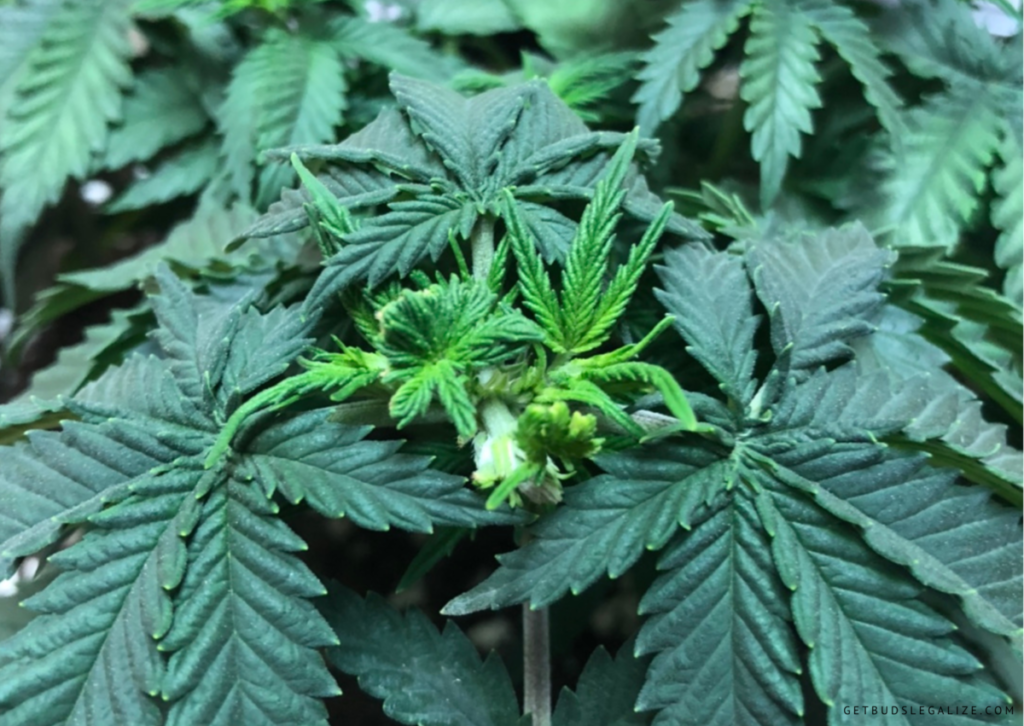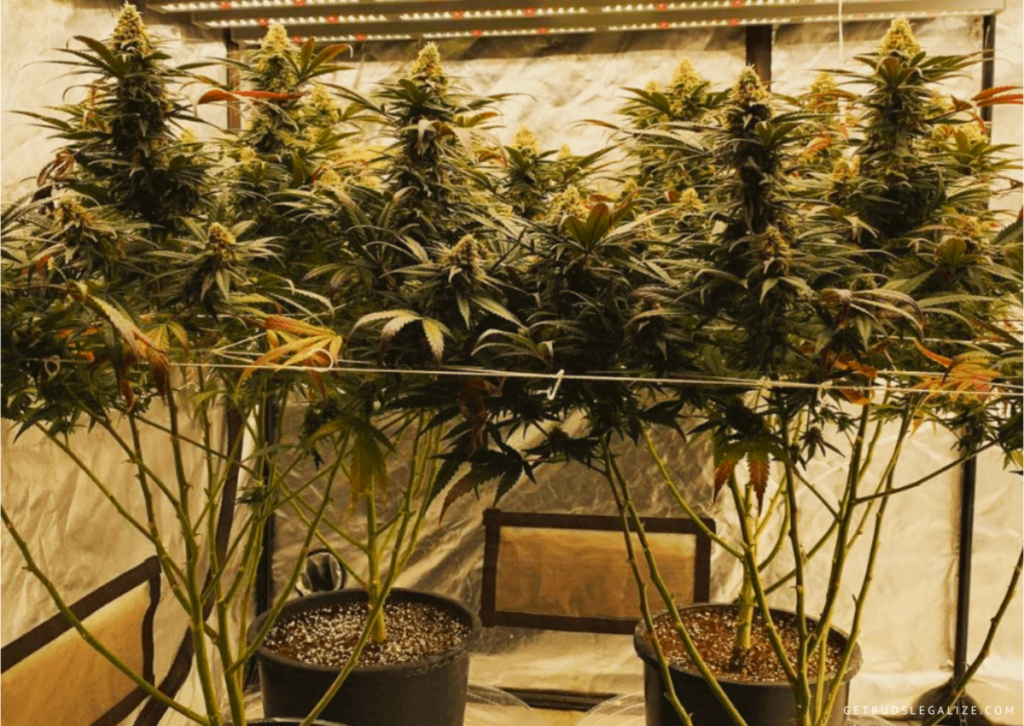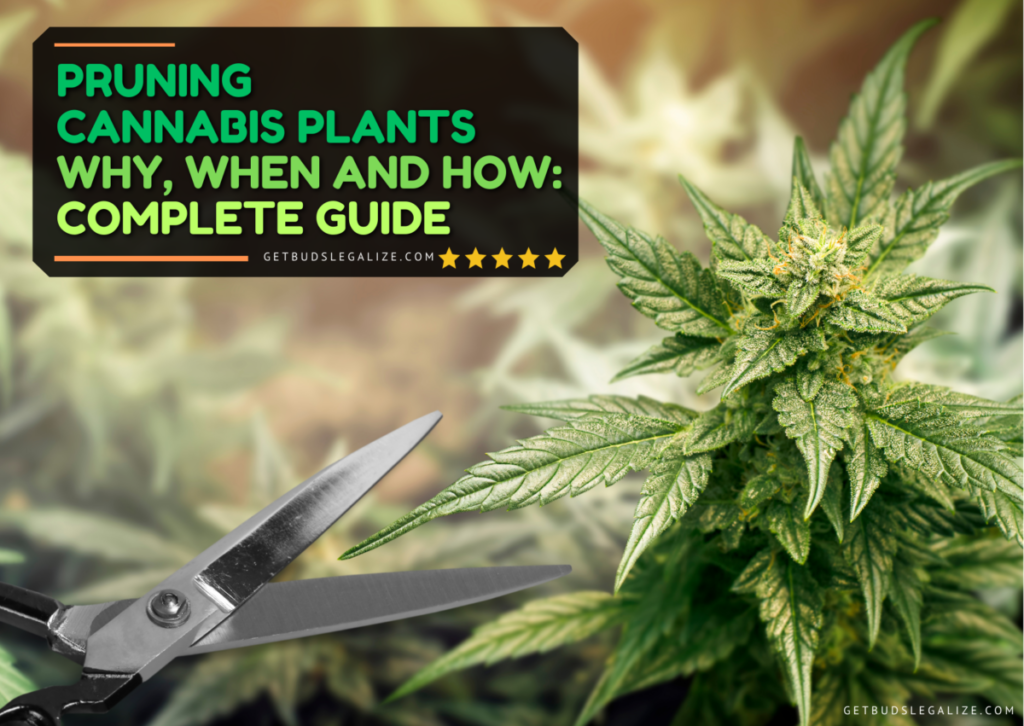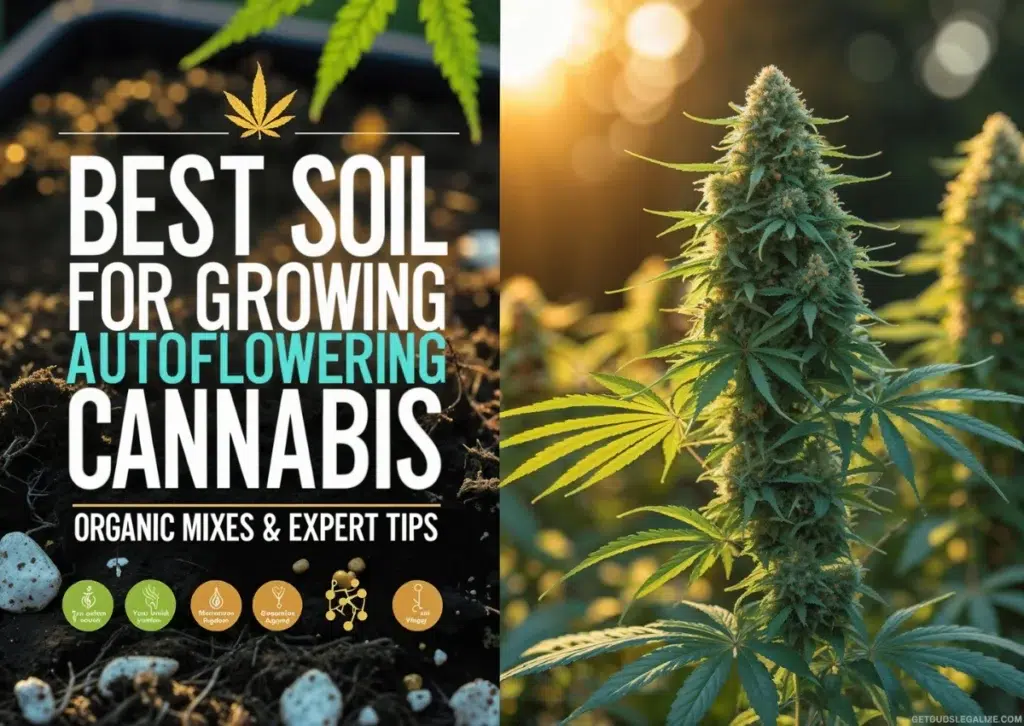Pruning Cannabis Plants - Why, When and How: Complete Guide
If you are growing cannabis for personal or medical use, you might want to consider pruning them to improve their yield and quality. Pruning is the process of removing unwanted parts of the plant, such as leaves, branches, or buds, to direct more energy and resources to the parts that you want to harvest. Pruning can also help you shape your plants and control their height, which can be useful if you have limited space or want to avoid detection.
There are different methods and techniques of pruning cannabis plants, depending on your goals and preferences. In this blog post, we will cover some of the basics such as when, why, and how to do it.
Cannabis Pruning Techniques:
There are several types of pruning methods that can be used on your plants, depending on the desired outcome and the stage of growth. Here are some of the most common ones:
Topping:

One of the most common pruning methods is topping, which involves cutting off the main stem of the plant above a node, where a pair of leaves or branches grow. Topping cannabis has several pros and cons.
Some of the pros of topping are:
- It creates a bushier plant of marijuana with more branches and colas, which can increase the yield and quality of the buds.
- It prevents the plant from growing too tall and out of control, which can be useful for indoor growers with limited space or stealth requirements.
- It improves the light distribution and airflow around the plant, which can prevent mold, pests, and diseases.
Some of the cons of topping are:
- It causes stress to the plant, which can slow down its growth and recovery time.
- It reduces the size and potency of the main cola, which some growers prefer to have as a trophy bud.
- It requires more maintenance and training, such as pruning, tying, and bending, to shape the plant and support its branches.
Fimming:

Fimming Marijuana is a technique that involves cutting off the top of a plant to encourage it to grow more branches and buds. Fimming is similar to topping, but instead of cutting off the entire stem, only about 75% of it is removed. This leaves behind four small shoots that can develop into four main colas. Fimming can be done during the vegetative phase of the plant when it has at least four nodes.
Some of the pros of fimming are:
- It can increase the number of bud sites and yield potential of the plant.
- It can create a more even canopy and improve light penetration to the lower branches.
- It can reduce the height and stretch of the plant, making it more suitable for indoor or stealth growing.
Some of the cons of fimming are:
- It can cause stress and damage to the plant if done incorrectly or too frequently.
- It can increase the risk of infection or pests if the cut is not clean or sterile.
- It can delay the flowering time and require more maintenance and training of the new branches.
Lollipopping:

Lollipopping is a pruning technique that involves removing the lower branches and leaves of a cannabis plant, leaving only the top buds that receive the most light. The goal of lollipopping is to increase the yield and quality of the harvest by focusing the plant’s energy and resources on the main colas.
Some of the pros of lollipopping are:
- It can improve air circulation and reduce humidity around the plant, preventing mold and pests.
- It can make watering and feeding easier, as well as trimming and drying after harvest.
- It can produce bigger and denser buds that have higher potency and better flavor.
Some of the cons of lollipopping are:
- It can stress the plant and stunt its growth if done too early or too aggressively.
- It can reduce the overall yield and diversity of the harvest by eliminating secondary buds that may have different cannabinoid and terpene profiles.
- It can expose the plant to light burn and nutrient burn if not adjusted accordingly.
Defoliation:

Defoliation involves removing some of the leaves from the plant to improve light penetration and airflow. Defoliation has pros and cons, depending on how and when it is done.
Some of the pros of defoliation are:
- It can increase the yield and quality of the buds by exposing them to more light and reducing the risk of mold and pests.
- It can stimulate the growth of new branches and leaves by redirecting the plant’s energy and hormones.
- It can improve the efficiency of nutrients and water uptake by reducing the transpiration rate and leaf surface area.
Some of the cons of defoliation are:
- It can stress the plant and reduce its overall health and vigor by removing its photosynthetic organs and wounding its tissues.
- It can lower the yield and quality of the buds by reducing the amount of sugar and resin production and triggering a defensive response from the plant.
- It can increase the risk of infection and disease by creating open wounds and exposing the plant to pathogens and pests.
What are the Benefits of Pruning Marijuana Plants?
Pruning is a beneficial practice that can improve the health and productivity of your plants. Here are some of the main advantages of pruning on cannabis:
1. Boosts plant growth: Pruning stimulates the growth of new branches and buds by redirecting the plant’s energy and resources. This can result in bushier and more vigorous plants that can produce more flowers.
2. Removes damaged growth and promotes better airflow and light exposure: Pruning helps you get rid of dead, diseased, or damaged parts of the plant that can attract pests or pathogens. It also allows more air and light to reach the lower parts of the plant, which can prevent mold and mildew from developing.
3. Boosts yields: Pruning can increase the quality and quantity of your harvest by focusing the plant’s energy on the most productive buds. By removing the lower branches and leaves that receive less light and produce smaller buds, you can optimize the plant’s efficiency and reduce waste.
4. Increases carbon dioxide intake and reduces infestation risks: Pruning can enhance the plant’s ability to absorb carbon dioxide, which is essential for photosynthesis and growth. It also reduces the chances of pest infestations by eliminating hiding places and improving ventilation.
5. Makes the most of available space: Pruning can help you manage the size and shape of your plants, especially if your grow room has limited space or height. You can train your plants to grow in a certain direction or pattern, such as topping, fimming, low-stress training, or high-stress training.
6. It’s free and easy: Pruning does not require any special equipment or skills. You can use a pair of scissors or your fingers to snip off unwanted growth. You just need to be careful not to overdo it or damage the main stem or branches.
When is the Best Time to Prune Marijuana Plants?

The best time to prune depends on several factors, such as the type of method used, the strain of cannabis, and the growing environment. However, there are some general guidelines that can help you decide when to prune your plants:
Prune early in the day: Pruning is stressful for plants, so it is better to do it when they have enough time to recover before nightfall. Pruning early in the day can also help prevent infections or pests from entering the wounds.
Prune during the vegetative phase: Most pruning methods should be done during the vegetative phase (except for lollipopping), when plants are growing rapidly and can heal faster. Pruning during the flowering can slow down bud development and reduce yield potential.
Prune before switching to 12/12 light cycle: If you are growing indoors and want to induce flowering by changing your light cycle from 18/6 or 24/0 to 12/12 (hours of light/darkness), you should prune your plants before making this switch. This can help them adjust better to the change and avoid stress or shock.
How to Prune Cannabis Plants Correctly
To prune cannabis correctly you will need some basic tools, such as:
- A sharp pair of scissors or pruning shears: These will help you to make clean and precise cuts without damaging the plant tissue. You should sterilize your tools before and after each use to prevent the spreading of diseases or pests.
- A pair of gloves: Pruning can be sticky and messy, especially when dealing with resinous buds. Gloves will protect your hands from the sticky sap and prevent contamination of the plant.
- A container or trash bag: You will need a place to dispose of the pruned parts of the plant. You can either compost them or throw them away, depending on your preference and local regulations.
The Basic Steps for Pruning Are:

1. Identify which branches need to be pruned:
These are usually the ones that are growing too close to the main stem, blocking light from reaching the lower parts of the plant or competing with the top buds for nutrients and space.
2. Cut off the unwanted branches using a sharp and sterile pair of scissors or pruning shears:
Make clean and precise cuts at a 45-degree angle, leaving a small stub of about 1/4 inch above the node. Avoid tearing or crushing the stem, as this can cause infections or slow down the healing process.
3. Apply a thin layer of pruning sealant or honey to the cut ends to prevent moisture loss and protect them from pathogens:
Alternatively, you can use a piece of tape or a Band-Aid to cover the wound.
4. Dispose of the pruned branches properly:
Do not leave them on the soil or near the plant, as they can attract pests or mold. You can either compost them, dry them for later use, or discard them in a sealed bag.
5. Monitor the plant’s response to pruning:
Pruning can cause stress and shock to the plant, so it is important to provide optimal conditions for recovery. Maintain a consistent temperature, humidity, and light cycle, and water and feed the plant as usual. Avoid overwatering or overfeeding, as this can cause more harm than good. You should see new growth and improved bud development within a few weeks after pruning.
Here are Some Tips to Follow and Some Common Mistakes to Avoid When Pruning Marijuana:
1. Prune during the vegetative stage, not the flowering stage: Pruning during the flowering stage can stress the plant and reduce its potency and yield. The vegetative phase is when the plant is growing its leaves and branches, and it can recover more easily from pruning.
2. Prune selectively, not excessively: Pruning too much can also stress the plant and stunt its growth. You should only prune the parts that are blocking light, airflow, or nutrients from reaching the main colas (the clusters of buds at the top of the branches). These parts include lower branches, fan leaves, and popcorn buds (small and airy buds that grow at the bottom of the plant).
3. Prune with clean and sharp tools, not with your fingers: Pruning with your fingers can damage the plant tissue and expose it to infections or pests. You should use clean and sharp scissors or pruning shears to make clean cuts that heal faster. You should also sterilize your tools before and after each use to prevent contamination.
4. Prune gradually, not all at once: Pruning all at once can shock the plant and slow down its growth. You should prune gradually over several days or weeks, giving the plant time to adjust and recover. You should also avoid pruning more than 20% of the plant at a time.
Conclusion
Pruning cannabis plants can be a rewarding and enjoyable technique that can improve your harvest significantly. However, you should always be careful and respectful when pruning your plants, as they are living beings that deserve your love and care. Happy pruning!
Pruning Cannabis Plants - FAQs
Pruning involves removing parts of the plant, such as leaves, branches, or buds, to improve its growth and health. Pruning can increase the yield of cannabis by allowing more light and air to reach the lower parts of the plant, stimulating the production of more buds. Pruning can also help shape the plant and prevent diseases and pests.
Pruning is a technique that involves removing parts of a cannabis plant to improve its growth and yield. There are different types of pruning training techniques, such as topping, fimming, lollipopping, and defoliation.
Each one has its own benefits and drawbacks, depending on the strain, environment, and goals of the grower. Pruning can help to create more branches, increase airflow, reduce pests and diseases, and enhance the quality and quantity of buds.
Removing fan leaves during the flowering phase is a controversial topic among cannabis growers. Some believe that it improves light penetration and airflow in your cannabis cultivation, while others argue that it stresses the plant and reduces its yield. There is no definitive answer to this question, as different strains and growing conditions may require different approaches.
However, a general rule of thumb is to avoid excessive defoliation and only remove leaves that are blocking subsites or showing signs of disease or nutrient deficiency.
Defoliation is the process in which leaves are removed from cannabis plants to improve light penetration and airflow. It can also stimulate growth and increase yields. However, defoliation should be done with caution and moderation, as overdoing it can stress the plants and reduce their health.
The optimal frequency of defoliation depends on several factors, such as the strain, the growing environment, and the stage of growth. Generally, defoliation should be done no more than once every two weeks during the vegetative phase, and once or twice during the early phases of flowering.
Defoliating too often or too late can interfere with the plant’s ability to produce buds and cannabinoids.
The best time to start depends on the type of plant and the desired outcome. Generally, pruning should be done during the vegetative stage, before the marijuana plant starts flowering. This allows the plant to recover from the stress of pruning and focus on producing buds. Pruning too late can reduce the yield and quality of the harvest.
Topping is a supercropping method that involves cutting off the main stem of the marijuana plant to create more branches and colas. Supercropping is a general term for various techniques that stress the plant to increase its growth and potency. Topping is one of the easiest and most effective ways to supercrop marijuana plants, especially if you want to limit their height and create a bushier structure.

















